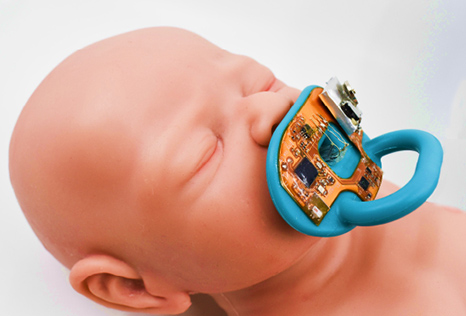At Washington State University a team developed a smart pacifier that can provide continuous monitoring of electrolyte levels in saliva. The measurements could help to avoid twice daily blood draws for premature infants. Blood draws are currently routine practice to monitor for signs of dehydration, which can be dangerous for infants born prematurely. The new pacifier uses microfluidic channels to draw saliva inside, and then sensors within the device measure sodium and potassium ion concentrations and transmit the data wirelessly to a caregiver through Bluetooth.
Premature infants are incredibly delicate and require a lot of care. Therefore, making this care as non-invasive as possible is desirable. Routine practices that are well-tolerated by adult patients, such as blood draws, are more severe for small babies, and developing techniques that can help avoid this are to be welcomed. “You often see NICU pictures where babies are hooked up to a bunch of wires to check their health conditions such as their heart rate, the respiratory rate, body temperature, and blood pressure,” said Jong-Hoon Kim, one of the developers of the new device. “We want to get rid of those wires.”
Dehydration can be dangerous for premature babies, and at present, healthcare staff will take a blood draw twice daily to measure electrolyte levels, and assess if dehydration is an issue. However, this is not only invasive for the baby, but it is labor intensive, and only provides a snapshot of electrolyte levels twice a day.
“We know that premature babies have a better chance of survival if they get a high quality of care in the first month of birth,” said Kim. “Normally, in a hospital environment, they draw blood from the baby twice a day, so they just get two data points. This device is a non-invasive way to provide real-time monitoring of the electrolyte concentration of babies.”
Methods to measure electrolyte levels in saliva do exist, but they typically require a saliva sample that is inserted into bulky equipment. These researchers turned to the pacifier as a way to obtain real-time measurements that do not require manual sampling or invasive blood draws.
The smart pacifier does not require a pump to move saliva about, as the microfluidic channels within it naturally draw saliva inside through capillary action. So far, the researchers have tested the device in a number of infants, and found that the electrolyte measurements it provides are comparable to those obtained using conventional blood draws.
Study in Biosensors and Bioelectronics: Smart bioelectronic pacifier for real-time continuous monitoring of salivary electrolytes
